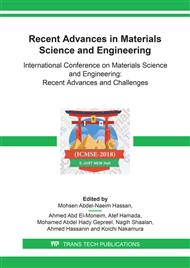p.52
p.57
p.65
p.75
p.87
p.98
p.104
p.119
p.128
Prominent Achievements of Laser Surface Treatment of Martensitic Stainless Steel and Alpha-Beta 6/4 Titanium Alloy
Abstract:
Conventional surface treatment processes are known to suffer from several limitations. Among them are energy consumption, complex heat treatment schedules and non-controllable heat affected zones. On the other side, when a high powered laser beam is used as a source of heat for surface treatment it will obviate most of these limitations. Laser surface engineering is one of these advanced surfacing technologies that receive growing interest to improve the surface properties of metals such as hardness, wear and corrosion resistance. Such treatments may be divided into two main categories: (i) those which only involve microstructural modification e.g. laser hardening and laser melting and (ii) other processes which lead to dual changes in microstructure and surface chemistry such as laser alloying and laser cladding. This paper comprises the experimental findings of two significant examples for laser surface engineering. The first study is concerned with surface hardening of AISI 416 martensitic stainless steel whereas the second study involves laser surface cladding of Ti-6Al-4V alloy. The outcome of the first work is a notable improvement of toughness at the same level of hardness and wear resistance as compared to the conventional hardening treatment. Additionally, the optimum condition for combined wear resistance, impact toughness and corrosion resistance was recorded at a laser heat input value of 21 J•mm-2. The second study is concerned with laser surface cladding of the titanium alloy with a powder blend composed of 60 wt% of WC and 40 wt% NiCrBSi alloy, by means of a high power Nd:YAG 2.2 kW laser. The best clad layers were obtained at a specific heat input of 60 J•mm-2. More than three-fold enhancement of the microhardness of the clad layers was achieved combined with a remarkable improvement of the alloy wear resistance.
Info:
Periodical:
Pages:
87-97
Citation:
Online since:
October 2018
Price:
Сopyright:
© 2018 Trans Tech Publications Ltd. All Rights Reserved
Share:
Citation:


